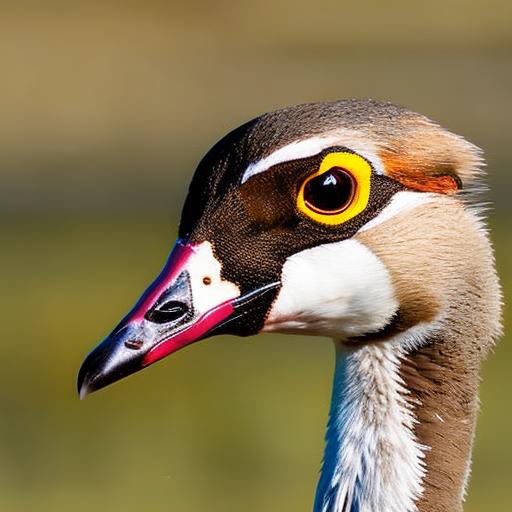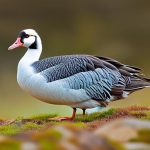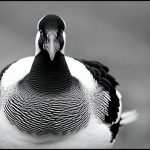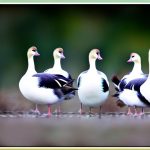The Egyptian Goose (Alopochen aegyptiaca) is a species of waterfowl native to Africa, particularly in the Nile Valley and sub-Saharan regions. Despite its name, the Egyptian Goose is not actually native to Egypt, but rather gets its name from the fact that it was first described by the ancient Egyptians. These geese are known for their striking appearance, with a chestnut brown body, white wing patches, and a distinctive dark eye patch. They are also known for their loud, honking calls, which can often be heard echoing across the wetlands and grasslands where they make their homes.
Egyptian Geese are monogamous birds, forming long-term pair bonds with their mates. They are highly territorial and will aggressively defend their nesting sites from intruders, including other waterfowl and even humans. These geese are also known for their strong, synchronized flight patterns, often flying in V-shaped formations as they migrate between their breeding and wintering grounds. Overall, the Egyptian Goose is a fascinating and important species in the ecosystems where it resides, and understanding its breeding and nesting behaviors is crucial for its conservation and management.
The Mating Ritual of Egyptian Geese
The mating ritual of Egyptian Geese is a complex and fascinating process that begins with the formation of pair bonds between males and females. These bonds are typically formed during the winter months, and once a pair bond is established, it is usually maintained for life. During the mating season, male Egyptian Geese will engage in elaborate courtship displays to attract females. These displays often involve the males flapping their wings, honking loudly, and performing various aerial acrobatics to impress potential mates.
Once a female has chosen a mate, the pair will engage in mutual preening and other bonding behaviors to strengthen their relationship. After the pair bond is established, the female will begin to search for a suitable nesting site, while the male will fiercely defend the chosen site from other geese and potential predators. The mating ritual of Egyptian Geese is a crucial part of their breeding behavior, and understanding the intricacies of this process is essential for their conservation and management.
Nesting Habits and Site Selection
Egyptian Geese are known for their strong nesting instincts and will go to great lengths to find a suitable site for their nests. They typically prefer to nest near water, such as in wetlands, marshes, or along the banks of rivers and lakes. The female will often choose a well-concealed site, such as a hollow in a tree, a dense thicket, or a secluded spot on the ground, to build her nest. Once a site is chosen, the female will begin to construct the nest using a combination of twigs, grasses, and other plant materials, lining the interior with down feathers for insulation.
The male will closely guard the nesting site, patrolling the area and aggressively chasing away any potential threats. Egyptian Geese are highly territorial during the nesting season, and they will not hesitate to defend their nests from other waterfowl, mammals, or even humans. The nesting habits and site selection of Egyptian Geese are crucial aspects of their breeding behavior, and understanding these behaviors is essential for their conservation and management.
Incubation and Hatching Process
Once the nest is constructed and the eggs are laid, the female Egyptian Goose will begin the incubation process. She will typically lay a clutch of 5-12 eggs, which she will incubate for around 28-30 days. During this time, the male will continue to guard the nesting site and bring food to the female, as she rarely leaves the nest during the incubation period. The eggs are a pale cream color and are often covered with down feathers and other materials to help keep them warm and protected.
As the incubation period progresses, the female will carefully turn the eggs several times a day to ensure that they develop properly. Once the eggs are ready to hatch, the female will emit soft clucking sounds to communicate with the embryos inside the eggs. The hatching process is a gradual one, with the chicks using their egg tooth to break through the shell. Once the chicks have hatched, they are covered in down feathers and are able to leave the nest within a day or two. The incubation and hatching process of Egyptian Geese is a critical stage in their breeding behavior, and understanding this process is essential for their conservation and management.
Parental Care and Protection of Goslings
After the chicks have hatched, both the male and female Egyptian Geese play important roles in caring for and protecting their offspring. The parents will lead their brood to the water, where the chicks will begin to forage for food and learn essential survival skills. The parents will closely supervise the chicks, teaching them how to find food, avoid predators, and navigate their environment. Egyptian Geese are highly protective of their goslings and will aggressively defend them from potential threats, including other waterfowl, mammals, and humans.
The parents will also provide warmth and shelter for the goslings, often huddling together to keep the chicks safe and secure. As the goslings grow, the parents will continue to provide guidance and protection, ensuring that their offspring have the best possible chance of survival. The parental care and protection of goslings is a crucial aspect of the breeding behavior of Egyptian Geese, and understanding these behaviors is essential for their conservation and management.
Feeding and Foraging Behavior
Egyptian Geese are primarily herbivorous, feeding on a variety of plant materials, including grasses, seeds, and aquatic vegetation. They are also known to consume small invertebrates, such as insects and snails, particularly during the breeding season when they need to provide extra nutrition for their growing chicks. Egyptian Geese are highly adaptable and will forage in a variety of habitats, including wetlands, grasslands, and agricultural fields.
The geese will often forage in small groups, using their keen eyesight and strong bills to search for food. They are also known to engage in grazing behavior, plucking grasses and other plant materials from the ground or water. Egyptian Geese are important seed dispersers, as they will often consume seeds and then spread them to new areas through their droppings. Understanding the feeding and foraging behavior of Egyptian Geese is crucial for their conservation and management, as it can help researchers and wildlife managers identify important habitats and food sources for these birds.
Communication and Social Structure
Egyptian Geese are highly social birds, often forming large flocks during the non-breeding season. Within these flocks, the geese will engage in a variety of communication behaviors, including honking calls, head bobbing, and various body postures. These communication behaviors are used to establish and maintain social hierarchies, attract mates, and coordinate group movements. Egyptian Geese are also known for their strong pair bonds, often forming long-term relationships with their mates.
During the breeding season, the geese will become more territorial and aggressive, particularly when it comes to defending their nesting sites and offspring. They will use a combination of vocalizations and physical displays to ward off potential threats and intruders. Understanding the communication and social structure of Egyptian Geese is essential for their conservation and management, as it can help researchers and wildlife managers better understand the dynamics of these birds within their ecosystems.
Factors Affecting Breeding Success
There are a variety of factors that can affect the breeding success of Egyptian Geese, including habitat quality, food availability, predation, and human disturbance. Loss and degradation of wetland habitats can have a significant impact on the ability of geese to find suitable nesting sites and forage for food. Invasive species, such as feral cats and rats, can also pose a threat to nesting geese and their offspring. Human disturbance, including recreational activities and development, can disrupt the nesting and foraging behaviors of Egyptian Geese, leading to decreased breeding success.
Climate change is also a growing concern for the breeding success of Egyptian Geese, as it can alter the timing of migration, nesting, and food availability. Understanding the factors that affect breeding success is crucial for the conservation and management of Egyptian Geese, as it can help researchers and wildlife managers identify and address threats to these birds and their habitats.
Conservation and Management of Egyptian Geese
Conservation and management efforts for Egyptian Geese focus on protecting and restoring their wetland habitats, minimizing human disturbance, and addressing threats from invasive species and climate change. Wetland conservation is a key component of efforts to protect Egyptian Geese, as these birds rely on these habitats for nesting, foraging, and raising their offspring. Restoring and creating new wetland habitats can provide important breeding and wintering grounds for geese, as well as other waterfowl and wildlife.
Minimizing human disturbance is also crucial for the conservation and management of Egyptian Geese, particularly during the breeding season. This can involve implementing regulations and guidelines for recreational activities, such as boating, fishing, and hunting, to reduce the impact on nesting and foraging geese. Addressing threats from invasive species, such as feral cats and rats, can also help protect nesting geese and their offspring. Finally, addressing the impacts of climate change on wetland habitats and food availability is essential for the long-term conservation of Egyptian Geese.
Future Research and Implications for Wildlife Management
Future research on Egyptian Geese should focus on understanding the impacts of climate change on their breeding and wintering habitats, as well as their food availability and migration patterns. This research can help identify potential conservation strategies and management actions to mitigate the impacts of climate change on geese and their ecosystems. Additionally, further research on the communication and social structure of Egyptian Geese can help wildlife managers better understand the dynamics of these birds within their habitats and develop effective conservation and management strategies.
Overall, the breeding behavior of Egyptian Geese is a complex and fascinating process that is crucial for their conservation and management. By understanding the mating ritual, nesting habits, incubation and hatching process, parental care, feeding and foraging behavior, communication and social structure, factors affecting breeding success, and conservation and management efforts for Egyptian Geese, researchers and wildlife managers can work to protect and preserve these important waterfowl for future generations.
Meet Walter, the feathered-friend fanatic of Florida! Nestled in the sunshine state, Walter struts through life with his feathered companions, clucking his way to happiness. With a coop that’s fancier than a five-star hotel, he’s the Don Juan of the chicken world. When he’s not teaching his hens to do the cha-cha, you’ll find him in a heated debate with his prized rooster, Sir Clucks-a-Lot. Walter’s poultry passion is no yolk; he’s the sunny-side-up guy you never knew you needed in your flock of friends!







